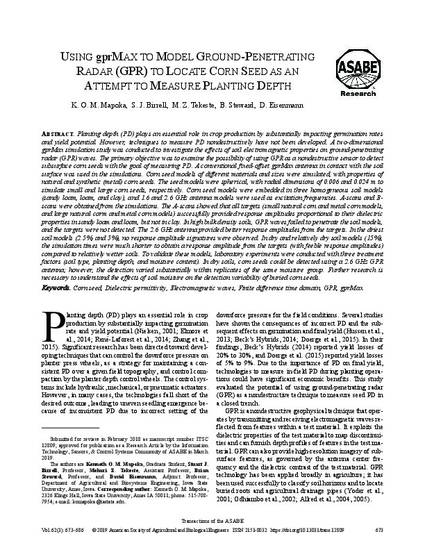
Planting depth (PD) plays an essential role in crop production by substantially impacting germination rates and yield potential. However, techniques to measure PD nondestructively have not been developed. A two-dimensional gprMax simulation study was conducted to investigate the effects of soil electromagnetic properties on ground-penetrating radar (GPR) waves. The primary objective was to examine the possibility of using GPR as a nondestructive sensor to detect subsurface corn seeds with the goal of measuring PD. A conventional fixed-offset gprMax antenna in contact with the soil surface was used in the simulations. Corn seed models of different materials and sizes were simulated, with properties of natural and synthetic (metal) corn seeds. The seed models were spherical, with radial dimensions of 0.006 and 0.024 m to simulate small and large corn seeds, respectively. Corn seed models were embedded in three homogeneous soil models (sandy loam, loam, and clay), and 1.6 and 2.6 GHz antenna models were used as excitation frequencies. A-scans and B-scans were obtained from the simulations. The A-scans showed that all targets (small natural corn and metal corn models, and large natural corm and metal corn models) successfully provided response amplitudes proportional to their dielectric properties in sandy loam and loam, but not in clay. In high bulk density soils, GPR waves failed to penetrate the soil models, and the targets were not detected. The 2.6 GHz antenna provided better response amplitudes from the targets. In the driest soil models (2.5%, and 5%), no response amplitude signatures were observed. In dry and relatively dry soil models (15%), the simulation times were much shorter to obtain a response amplitude from the targets (with feeble response amplitudes) compared to relatively wetter soils. To validate these models, laboratory experiments were conducted with three treatment factors (soil type, planting depth, and moisture content). In dry soils, corn seeds could be detected using a 2.6 GHz GPR antenna; however, the detection varied substantially within replicates of the same moisture group. Further research is necessary to understand the effects of soil moisture on the detection variability of buried corn seeds.
Available at: http://works.bepress.com/brian_steward/84/

This article is published as Mapoka, Kenneth OM, Stuart J. Birrell, Mehari Tekeste, Brian Steward, and David J. Eisenmann. "Using gprMax to Model Ground Penetrating Radar (GPR) to Locate Agricultural Corn Seed As an Attempt to Measure Planting Depth." 62, no. 3 Transactions of the ASABE (2019): 673-686. DOI: 10.13031/trans.12809. Posted with permission.